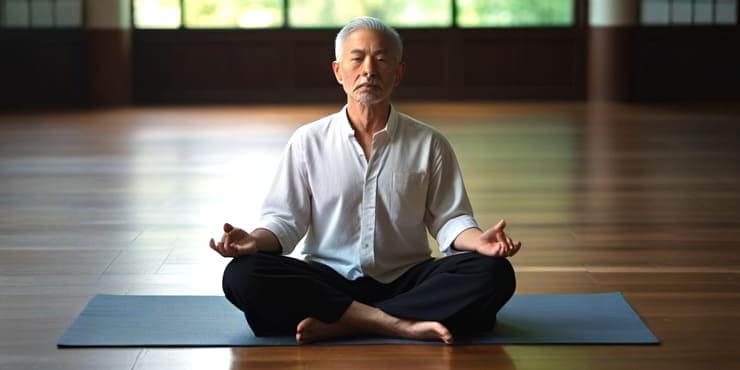The Life-Changing Power of Deep Breathing

Estimated reading time: 10 Min
The power of deep breathing is at the heart of wellness and balance. A practice both ancient and remarkably simple that has a remarkable effect on productivity.
Historically, from the yogis of India to the Zen masters of Japan, breathing has been harnessed as a powerful means to influence physical, mental, and spiritual well-being.
Exploring the power of a practice as simple as breathing might seem almost too straightforward at first glance.
However, beneath this basic human function is a gateway to health benefits, emotional balance, and enhanced performance.
While the act of breathing is as natural as the air we breathe, conscious deep breathing is a potent tool often overlooked in the modern quest for health and productivity.
This article aims to demystify the life-changing power of deep breathing by exploring its multifaceted benefits, delving into practical techniques, and showcasing how it can be seamlessly integrated into daily life for enhanced well-being and personal growth.
Understanding The Power Of Deep Breathing
The Science of Breathing
Breathing might seem instinctive, but there’s a vast difference between automatic breathing and deep, conscious breathing.
The latter involves drawing air deep into the lungs, where oxygen exchange is most efficient, leading to improved oxygenation of the body.
This process stimulates the parasympathetic nervous system, promoting a state of calm and helping to reduce stress levels.
The Psychology of Breath
Breathing is intricately linked to our emotions and state of mind.
Stressful situations often trigger shallow, rapid breathing, heightening anxiety and tension.
Conversely, deep breathing exercises can slow down the heart rate and signal the brain to enter a state of calm, creating a natural counterbalance to stress.
The Benefits of Deep Breathing
Physical Health Improvements

Deep breathing acts as a powerful ally for physical health.
It enhances oxygenation, boosts blood flow, and supports the lymphatic system, contributing to the effective removal of toxins.
Regular practice can lead to lower blood pressure, reduced chronic pain, and a strengthened immune system, laying a foundation for lasting health.
Mental Clarity and Emotional Balance
The mind-body connection finds a clear expression in the practice of deep breathing.
By alleviating stress and reducing the body’s stress response, deep breathing exercises can sharpen focus, improve decision-making capabilities, and foster a sense of inner peace.
Furthermore, they can be a key component in managing mood, combating anxiety, and promoting emotional resilience.
Performance Enhancement
Deep breathing is not just about achieving tranquility; it’s also a tool for enhancing physical and creative performance.
In sports, efficient oxygenation can improve endurance and recovery times.
For creative endeavours, the clarity and focus gained from deep breathing pave the way for heightened creativity and problem-solving abilities.
Drawing on personal experiences from the worlds of sports and music, the enhancement of performance through deep breathing is both significant and multifaceted.
Techniques and Practices
Basic Deep Breathing Exercises
Starting with deep breathing practices can be as simple as focusing on your breath.
A basic exercise involves inhaling slowly and deeply through the nose, allowing the chest and lower belly to rise, and then exhaling gently, either through the nose or mouth.
This can be done for several minutes, focusing on the rhythm and sensation of the breath.
Integrating Deep Breathing into Daily Life

Making deep breathing a habitual practice can transform its benefits into a consistent part of your daily well-being.
Simple strategies include setting reminders to take deep breathing breaks.
Use deep breaths as a transition between different parts of your day, and practice mindful breathing during routine activities like walking or waiting in line.
Advanced Practices
For those looking to deepen their breathing practice, techniques such as pranayama in yoga offer a range of exercises designed to control and extend the breath.
These practices, often accompanied by specific postures or meditation, can be explored under the guidance of a qualified instructor to unlock further benefits and insights into the power of breath.
By understanding the mechanisms behind deep breathing, recognising its wide-ranging benefits, and incorporating its practice into our lives, we embark on a path to enhanced health, clarity, and performance.
This simple yet profound act of taking a deep breath not only nurtures the body and mind but also opens up a space for growth, resilience, and a deeper connection with ourselves.
Deep Breathing for Personal Development
Building Resilience
In a world that often feels like it’s moving at breakneck speed, the ability to remain calm and centred is more valuable than ever.
Deep breathing stands out as a beacon for building resilience.
By regularly engaging in deep breathing exercises, individuals can develop robustness against the daily stresses of life.
This resilience extends beyond mere endurance, fostering a capacity to thrive amidst challenges.
Enhancing Mindfulness and Presence
Mindfulness—the art of being fully present in the moment—can be significantly enhanced through deep breathing.
By focusing on the breath, individuals can anchor themselves in the now, cutting through the noise of distractions and engaging more deeply with their environment and the people in it.
This heightened sense of presence is not only beneficial for personal well-being but also enriches interactions and relationships.
A Tool for Creativity and Problem-Solving
For artists, entrepreneurs, and anyone involved in creative or strategic thinking, deep breathing can be a powerful tool to unlock creativity and facilitate innovative problem-solving.
By calming the mind and reducing overthinking, it creates a space where inspiration can flow freely, and new ideas can emerge with clarity.
Case Studies and Success Stories
Real-life stories abound of individuals who have transformed their lives through the practice of deep breathing.
From high-performance athletes who have found an edge in their physical and mental preparation, to busy professionals who have discovered a sanctuary of calm amidst the chaos of corporate life, the stories are as diverse as they are inspiring.
Each case study highlights a unique journey of discovery, challenge, and transformation, underscoring the universal applicability and effectiveness of deep breathing.
Case Study 1: The Olympian’s Edge, James Carter
Background
James Carter, an American Olympic runner specialising in the 400-metre hurdles, faced intense pressure and competition. Despite his rigorous physical training, James struggled with anxiety before races, which affected his performance.
Challenge
The challenge was twofold: maintaining peak physical condition and overcoming the mental barriers that anxiety and stress before competitions posed.
Journey
James began incorporating deep breathing techniques into his training regimen after consulting with a sports psychologist. He started with simple diaphragmatic breathing exercises, progressing to more structured practices like the 4-7-8 technique (inhaling for 4 seconds, holding for 7 seconds, and exhaling for 8 seconds) to calm his mind before races.
Transformation
The impact was profound. James reported a significant reduction in pre-race anxiety, improved focus, and better sleep in the nights leading up to competitions. His performance improved noticeably, attributing his enhanced mental clarity and calmness to his deep breathing practice.
Outcome
James went on to achieve personal bests in subsequent Olympic Games and credited deep breathing as a critical component of his mental preparation, providing him with a competitive edge that was as vital as his physical training.
Case Study 2: The Executive’s Oasis, Sofia Alvarez
Background
Sofia Alvarez, a high-ranking executive in a Fortune 500 company, faced the daily grind of high-stakes decisions, constant travel, and the pressure of leadership. This relentless pace led to chronic stress and minimal personal time, affecting her health and well-being.
Challenge
Sofia needed to find a way to manage stress effectively, improve her decision-making abilities, and maintain her health despite her demanding career.
Journey
When attending a wellness seminar, Sofia was introduced to deep breathing exercises aimed at stress reduction. She began dedicating a few minutes at the start of her day and during transitions between meetings to practice deep breathing.
Transformation
Sofia experienced a notable decrease in stress levels, enhanced clarity in decision-making, and a newfound sense of calm amidst the chaos of her professional life which led to even greater productivity.
Deep breathing became her “oasis” – a tool she could use anytime, anywhere.
Outcome
Armed with deep breathing techniques, Sofia navigated her responsibilities with renewed vigour, improved health, and increased productivity. Her story became an inspiration within her company, leading to the introduction of mindfulness and wellness programmes for employees.
Case Study 3: The Artist’s Renaissance, my performance
Background
When I was in my early teens, walking on to a stage to perform as a young violinist, I struggled with performance anxiety.
Challenge
My primary challenges was overcoming stage fright.
Journey
An enlightened music teacher, Mr Rock, taught me a simple deep breathing technique, particularly focusing on rhythmical breathing to align with the speed and rhythm of my music. I included these techniques in my daily practice and before performances.
Transformation
Not only did my performance anxiety diminish, but I also found that deep breathing improved my confidence in musical expression, enabling greater emotional commitment and depth.
Outcome
Having thought at one time of giving up, I went on to perform professionally including solo roles in the Royal Albert Hall in London. Deep breathing not only helped me overcome my anxiety but had also given me more confidence to express myself.
Overcoming Common Challenges
While the benefits of deep breathing are extensive, beginners may encounter hurdles.
Here’s how to overcome some common challenges:
Common Misconceptions
One widespread myth is that deep breathing is time-consuming or requires special conditions to practice.
In reality, deep breathing exercises can be integrated into various moments throughout the day, without needing to alter one’s schedule significantly.
Troubleshooting Guide
Difficulty concentrating or physical discomfort can sometimes hinder practice.
If concentration is a challenge, try focusing on different aspects of the breath, such as its sound or the sensation of air moving through the nostrils.
For physical discomfort, experimenting with posture or trying different breathing techniques can offer solutions.
FAQs
1. What is the best time of day for deep breathing exercises?
The beauty of deep breathing is its flexibility; it can be practiced at any time of day. However, many find starting their day with deep breathing sets a positive tone, while others prefer it as a tool to unwind before sleep. If you’re like me, you might do both!
2. Can deep breathing help with anxiety and panic attacks?
Yes, deep breathing is a recognized method for managing anxiety and panic attacks. It helps by activating the body’s natural relaxation response, reducing immediate stress, and helping to centre the mind away from panic triggers.
3. How long does it take to see benefits from regular deep breathing practices?
While immediate calm can be felt during and shortly after deep breathing exercises, long-term benefits such as reduced stress levels, improved concentration, and better sleep quality can become noticeable after consistent practice for two to four weeks.
4. Are there any risks or people who should avoid deep breathing exercises?
Deep breathing is safe for the vast majority of people. However, individuals with certain medical conditions (e.g., respiratory issues like asthma) should consult a healthcare professional before beginning any new breathing practices.
5. How can I measure the impact of deep breathing on my health and wellbeing?
The impact of deep breathing can be observed through personal reflection on changes in stress levels, emotional state, and physical health. Additionally, keeping a journal to note changes in mood, sleep quality, and overall well-being can provide concrete evidence of its benefits.
Summary
Deep breathing is more than a mere relaxation technique; it is a powerful, accessible tool that promotes physical health, mental clarity, emotional balance, and personal development.
Throughout this exploration of deep breathing, we’ve uncovered the scientific underpinnings that make it so effective, the wide array of benefits it offers, practical exercises to get started, and strategies for integrating it into daily life.
We’ve also delved into how deep breathing can enhance resilience, mindfulness, creativity, and problem-solving abilities, providing real-life success stories as inspiration.
Despite its simplicity, deep breathing can sometimes pose challenges, but with the right approach and mindset, these can be easily overcome.
The journey through the art of deep breathing reveals its incredible potential to transform lives.
Its benefits extend far beyond the moments of practice, influencing every aspect of our being and enhancing our experience of life.
The practice of deep breathing is a testament to the power of simple actions to provoke profound changes.
It requires no special equipment or conditions, just a commitment to pause and breathe deeply.
If you’re looking to cultivate a sense of calm, improve your health, and unlock your full potential, start incorporating deep breathing into your daily routine.
Begin with just a few minutes each day and gradually increase as you become more comfortable with the practice.
Remember, the journey of a thousand miles begins with a single breath.
By embracing deep breathing, you’re not just taking a step towards better health; you’re opening the door to a more mindful, resilient, and vibrant way of living.
By exploring the following resources, you can deepen your understanding and practice of deep breathing, and further enhance its transformative impact on your life.
Remember, the journey to wellness and self-improvement is ongoing, and incorporating deep breathing is a simple yet profound step you can take today.
Breathe deeply, live fully.
😉
Richard
Useful Resources
To further explore the practice of deep breathing and its benefits, consider delving into the following resources:
- Books:
- “The Healing Power of the Breath” by Richard P. Brown and Patricia L. Gerbarg – Offers simple breathing techniques for reducing stress and improving overall health.
- “Breath: The New Science of a Lost Art” by James Nestor – Explores the history, science, and art of breathing, and how it can impact health and performance.
- Apps:
- Websites:
- The Art of Living (www.artofliving.org): Provides articles, courses, and workshops on breathing techniques and their benefits.
- Yoga Journal (www.yogajournal.com): Offers a wealth of information on pranayama (breath control techniques) and how to integrate them into your yoga practice.






